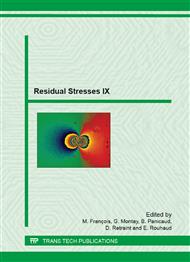[1]
M. Klein, H. Spindler et al., Thermomechanically Hot Rolled High and Ultra High Strength Steel Grades - Processing, Properties and Application, Mater. Sci. Forum, 500-501 (2005) 543–550.
DOI: 10.4028/www.scientific.net/msf.500-501.543
Google Scholar
[2]
O. Grong, Metallurgical Modelling of Welding, Institute of Materials, (1997).
Google Scholar
[3]
EN 1011-2: Welding - Recommendation for Welding of Metallic Materials - Part 2: Arc welding of ferritic steels, (2001).
DOI: 10.3403/02065964u
Google Scholar
[4]
K. Satoh, Restraint Stresses/ Strains v. Cold Cracking in RRC Test of High Strength Steel, in: Proceedings, Conference on Residual Stresses in Welded Construction and their Effects, London, 1977, p.283–289.
Google Scholar
[5]
P. Wongpanya, T. Boellinghaus, Residual Stress Distribution in Competing S 1100 QL Butt-Welds Dependent on Plate Thickness and Restraint Length, in: Proceedings, Conference on High Strength Steels for Hydropower Plants, Takasaki, (2009).
Google Scholar
[6]
T. Boellinghaus, T. Kannengiesser, M. Neuhaus, Effects of the Structural Restraint Intensity on the Stress Strain Build Up in Butt Joints, Mathematical Modelling of Weld Phenomena 7 (2005), 651–669.
Google Scholar
[7]
W. Jiang, X.P. Xu, J.M. Gong, S.T. Tu, Influence of Repair Length on Residual Stress in the Repair Weld of a Clad Plate, Nuncl. Eng. Des. 246 (2012) 211–219.
DOI: 10.1016/j.nucengdes.2012.01.021
Google Scholar
[8]
M. Hirohata; Y. Itoh, Effect of Restraint on Residual Stress Generated by Butt-welding for Thin Steel Plates, in: Proceedings, 9th German-Japanese Bridge Symposium, Kyoto, (2012).
Google Scholar
[9]
P. Dong; J.K. Hong; P.J. Bouchard, Analysis of Residual Stresses at Weld Repairs, Int. J. Pres. Ves. Pip. 82 (2005) 258–269.
DOI: 10.1016/j.ijpvp.2004.08.004
Google Scholar
[10]
D. Schroepfer, T. Kannengiesser, T. Lausch, Investigations of the Influence of Heat Control on the Residual Stress Build-up and Overall Stress in Welded Joints of High-strength Fine-grained Structural Steel, DVS Berichte 296 (2013).
Google Scholar
[11]
T. Lausch, T. Kannengiesser, M. Schmitz-Niederau, Multi-Axial Load Analysis of Thick-Walled Component Welds Made of 13CrMoV9-10, J. Mater. Process. Tech. 213 (2013) 1234–1240.
DOI: 10.1016/j.jmatprotec.2013.01.008
Google Scholar
[12]
T. Kannengiesser, T. Lausch, A. Kromm, Effects of Heat Control on the Stress Build-up During High-strength Steel Welding under Defined Restraint Conditions, Weld. World 55 (2011) 58–65.
DOI: 10.1007/bf03321308
Google Scholar
[13]
K. Satoh, Y. Ueda, S. Matsui et al., Tsuji: Japanese Studies on Structural Restraint Severity in Relation to Weld Cracking, Weld. World 15 (1977) 155–189.
Google Scholar
[14]
T. Nitschke-Pagel, H. Wohlfahrt, Residual Stresses in Welded Joints - Sources and Consequences, Mater. Sci. Forum 404-407 (2002) 215–226.
DOI: 10.4028/www.scientific.net/msf.404-407.215
Google Scholar


